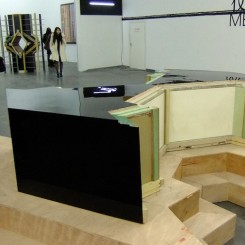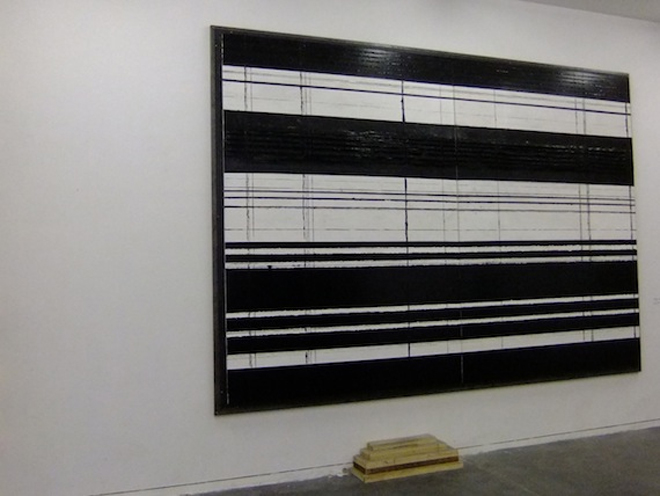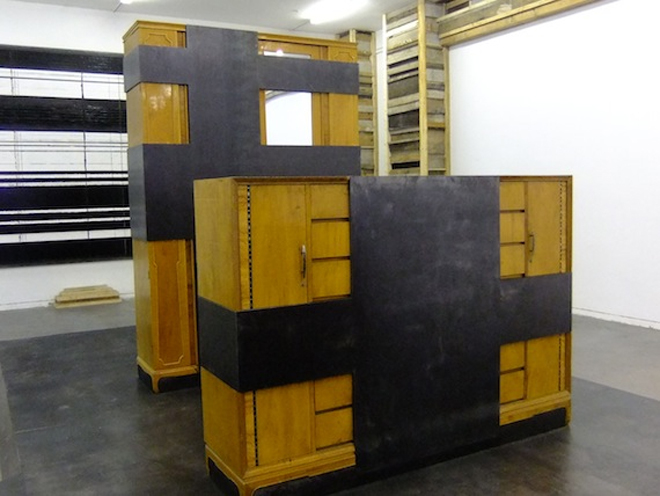Art history, as a scholarly practice, is confined by a certain code of ethics in terms of interpreting actual influence and patterns of change within the art of an era; criticism, although it is often referred to as a first draft for art historical writing, is subject to no such fidelity to narrative, and occasionally even attempts to influence the realities of the art with which it interacts. The art historian can move only in one direction, seeking connections but attempting, always, to leave aside the question of the future in relation to any given moment in order to locate the intrinsic properties of the work at hand. One of the greatest pleasures of the art critic, therefore, is to cast off this temporal arrow and move in the opposite direction, to seize upon the objects of the present and follow the shadows of their forms into the past, further and further back until, at last, the seed of all that now exists is located in the earliest projects and feeblest lines of an artist or writer. A perfect opportunity for this exercise, inefficient and undemanding as it is, presents itself in the form of “Trilogy,” the latest solo exhibition by the Beijing artist Liu Wei, precisely the kind of artist whose every move is predicated on some version of his past and who draws lines of comparison and analogy across years and series. This is an archaeology of invisible traces, one that never fails to position the past work of the artist within the framework of his present but may necessarily be discarded immediately upon the production of a newer body of work—one that may not be tied to the mold presented here.
Take, simply as the most easily accessible example, the paintings that seem to constitute the walls of this exhibition in a highly sculptural way, literally framing the main event—a role played by the aggressive installation components that spread from room to room—by providing it with a strict horizontal limit. These paintings seem primarily indebted to a video aesthetics, as if the face of the canvas were a winking reproduction of a closed-circuit feedback loop caught in the midst of its cycle. As much as they absorb this lens-based process of vision in stride, however, they also deaden it, adding a decidedly monumental mass to the picture plane in such a way that the cyberpunk levity of Liu Wei’s best-known paintings, the “Purple Air” series (2006-2010) is almost literally crushed. Whereas Chris Moore sees in these new pieces a determined horizontality that responds to the Western landscape tradition, for me they mark a material transformation of the verticality of “Purple Air”; the transition is not one of viewing paradigm so much as it is one of density, crushing the buildings and lights that soared upward in the apocalyptic cityscapes of the past several years and rolling them back into immensely heavy sheets of thick gray material—perhaps an approach to the steel and molten glass that lies beneath neon signs and curtain walls. Paintings like “Meditation” (2011) contain “Purple Air,” neither denying the verticality of the latter nor offering an essentialist presentation of dimension or meaning in their own right. Within the project of “Trilogy” as a whole, this picture is a concrete wall containing and funneling flows of light and vision.
Then there is “Power” (2010-2011), a collection of old and gray CRT television sets in plastic housings of various colors arranged in stacks at the center of the final room of “Trilogy.” Each television turns on and off in turn—seemingly at random although the electronic circuitry at work is never made available to the viewer—so as to produce sets of horizontal bright lines across the bleak surface of the monitor, letting off also a satisfying if slightly nerve-wracking crack of the sort that might accompany a surge of static electricity. This makes it a highly tangible piece of spatial engineering, and the entire room is set up so as to feel something like a revelation at the end of the exhibition: if the reader was, at any point, not convinced that the paintings are somehow manual screens opening into a video realm of signal and noise, this fact is now painfully obvious, almost to the point of belligerence. But there is a certain slippage that occurs between video painting, which might be read as a reference to the experimental histories of screen-based new media practice, and this use of a physical video apparatus used in a mode that is explicitly alien to the histories of media art (that is to say, as a component of junk sculpture without any reference to medium whatsoever), and this is a tension that should probably be preserved. Returning to the project of archaeology, it must be noted that this installation first appeared in another form in a massive warehouse-style space in Caochangdi on the edges of Beijing, a site in which it seemed to owe more to the electronic flea markets throughout the surrounding urban villages—and a sympathetic anthropology thereof—than the art historical and technical references that emerge in this crisp iteration for Shanghai.
It would be difficult to overestimate the influence of that particular Caochangdi space over the later development of Liu Wei’s installation practice, particularly in terms of the body of work that surrounded “The Outcast” (2007), a massive glass building constructed of reclaimed wooden windows and doors, many of them painted the pale green that signifies institutional architectures from the Chinese context like schools and hospitals, and containing broken furniture and dead trees besieged by a dust storm whipped up by industrial-strength electric fans. Functioning as an extension of the artist’s studio in some way, this particular exhibition managed to absorb the outside world and recreate it in microcosm within the territory of art, albeit within an immediate environment that could only generously be described as a white cube; the brute nastiness of the dusty and decaying stretch between gallery and studio very much became the content of the work, and this thematic has since tempered the exuberance of color and form in Liu Wei’s more graphic-oriented work. Moreover, a number of formal concerns that first appeared in that project are echoed again within the more finished environments of “Trilogy.” There is, of course, the question of scale: “The Outcast” is probably the largest piece the artist has completed in physical terms, and he certainly revels in the power dynamics that emerge when viewers of an exhibition can only look upwards and, to some degree, cower in terror to take in the full vision of his work. This is present particularly in “Golden Section” (2011), a portion of which consists of shipping crates that form pillars and walls in the lobby of this latest exhibition—signaling directly and immediately that scale works only in one direction. In a more nuanced way, “The Outcast” also pioneered the use of a certain set of observer relations, offering a spectacular site of destruction within a (leaking) glass pavilion. This measure of distance—which wavers between critical and alienating—has never disappeared for Liu Wei, especially in the institutional setting. No matter how we are instructed to “Open the door,” as the wall text in the Minsheng galleries notably commands, the body is never allowed to come into contact with the forces that threaten it.
A central aspect of “Trilogy” and one of the major talking points at the 2010 Shanghai Biennale (and even prior to that, in its first incarnation at Long March Space), “Merely a Mistake” (2010-2011) might also be one of the most exciting works on view here from a critical perspective simply because it offers so much pseudo-archaeological material ripe for exploitation. It consists, in its final appearance, of layer upon layer of salvaged wooden frames and cuttings, many again appearing in the institutional green of “The Outcast” but also now with blue, yellow, and black; these structures come together with visible bolts and other pieces of hardware to form architectural towers, halls, and more abstract forms, recalling everything from a cathedral to a playground. In terms of material and working process the debt to the works described above is obvious, but there is a slightly more theoretically inflected bent that may prove productive for this particular set of pieces. For the series known as “As Long as I See It” (2006) but also including a range of other smaller pieces individually titled “Cigarettes and Ashtray” (2006), “Brick” (2006), and so on, Liu Wei shot Polaroid instant photographs of everything from particular objects to full landscapes. Then he cut through the actual objects according to how they were positioned within the frame of the photograph: where trees were cut off at the top of the image, he hacked them down to size; where a brick strayed across a composition, he sliced it accordingly; where a pool table and sofa spanned the width of the picture, he created a new form of physical perspective. This is, of course, a bold claim of the power of vision and reception over the external world, but I am primarily interested in how this way of working has influenced the artist through later projects. In “Red Disturbs Green” (2009), which consists of a number of horizontal neon lights transecting a green bush on a concrete frame, all cut into an absurdly rectilinear form, we find a highly poetic visual quotation of “As Long as I See It No. 1″ (2006), the piece that cut a series of trees on a concrete block. “Golden Section” (2011), a set of angular black blocks that come together appropriately from only one certain perspective in the room, similarly develops this notion of ideal perspective, perhaps also drawing on the observation dynamics of “The Outcast.” And while there is certainly a bit of Gordon Matta-Clark to “Merely a Mistake,” Liu Wei’s cuttings function in a much more visual way—transposing the failed realities of perception onto space rather than allowing ideal forms to come into being.
One of the first objects the viewer encounters in the Minsheng space is a series of towers and other architectural structures made of books, no doubt first carved and then perhaps pulped together for consistency. Comparisons with “Love It, Bite It” (2007) and other architectural works in oxhide are inevitable, but here it is the differences in material practice that are instructive: rather than working in the organic and highly tactile mode of dog chew toys, which themselves present an allegorical possibility that verges into dangerously spectacular territory, the transition to using black-and-white text on paper seems to continue the video aesthetics visible in the paintings present in this exhibition. Like the television sets in “Power,” the media capacity of these books as information carriers is destroyed along with any possible reference to their content and transmission capabilities, but still there is an insistence on this media aesthetics. These latest towers are also significantly more rectilinear, replacing in some way the oppressive vertical lines of “Purple Air” even as they are abandoned on the picture plane; the potential of organic growth, always present in pieces like “Love It, Bite It,” has been abandoned in favor of the critical right angle. The piece may draw its interest in waves of deconstruction and reconstruction from the oxhide works, but the aesthetic is borrowed more precisely from the “Porcelain” series (2006-2007): formal repetition, strict symmetry, and the superficial reference to technological forms despite the lowliest of materials.
This last aspect has become something of a marker for Liu Wei, allowing him to traffic in questions of technology and transformation without ever having to leave the discourse of contemporary art proper. We find this mode of thinking again in “Antimatter” (2006), the series for which the artist tackled certain domestic appliances and consumer electronics by tearing out their innards and creating cyberpunk objects that might reasonably have emerged from the world of the “Purple Air” paintings—again, however, owing more to the secondhand electronics markets of semi-rural Beijing than to any particular imagination of the future. In terms of technique, however, what Liu Wei gathered from this stage of his practice was assemblage—an aspect of his work that may have gone missing with “Trilogy.” True, “Merely a Mistake” nods to the use of salvaged furniture and its sculptural renewal, but the messy logic of assemblage, which rightfully births a new and unitary if divisible object through the accumulation of constituent components, fails to materialize. This is both the strongest and most dangerous moment of this exhibition, particularly in its institutional environment: this body of work is aesthetically consolidated, but, without an air of experimentation, it is unclear what the artist might actually do next. The experiment provides an eternal open door, a way out of failed projects and into new territories. Here we find no obvious failures—but nor do we see an indication of evolution beyond the present situation.
Critical archaeology attempts to locate our dislocated present in the material past, reading vertically through the aesthetics of a mass of history that can only be produced horizontally. I would like to propose an archaeology of the sort I have deployed in my reading of Liu Wei’s “Trilogy” as a potential working method for the artist; it is, after all, an approach to temporality that I first gathered from his ideas of experimentation, and it seems to offer a coherent stylistic narrative able to subsume both the laboratory process that characterizes his studio and the finished objects and arrangements that so carefully lay out his arguments for the audience. I recall an interview with the artist at his studio in early 2009, when he explained for me his working methods in a way that masterfully summarized and yet exposed the very foundations of his approach to artistic knowledge: everything, from the landscapes of “Purple Air” to the structures of “The Outcast,” is drawn from the brief drive from his home to his studio. Perhaps a 20-minute ride, this short line presents a cross-section of contemporary Beijing, from the relatively upscale area of Lido past the art district at 798 and into the Huantie, a testing track for railway locomotives that has been colonized by studio communities. Liu Wei draws a simple horizontal line across the map, and out of this emerge an entire plane of vertical developments, growing outward and into the territory of reception of his audience. By reading history at an angle perpendicular to its production we are able to draw narratives, like this one, that offer something of value to the present—albeit something transient, a form of knowledge that will necessarily disappear as soon as the horizontality of chronology is allowed to accumulate a further stage of cultural production.







